AMD FX-8370E CPU Review: Vishera Down to 95W, Price Cuts for FX
by Ian Cutress on September 2, 2014 8:00 AM ESTCPU Benchmarks
The dynamics of CPU Turbo modes, with both Intel and AMD, can cause concern during environments with a variable threaded workload. There is also an added issue of the motherboard remaining consistent, depending on how the motherboard manufacturer wants to add in their own boosting technologies over the ones that Intel would prefer they used. In order to remain consistent, we implement an OS-level unique high performance mode on all the CPUs we test which should override any motherboard manufacturer performance mode.
HandBrake v0.9.9: link
For HandBrake, we take two videos (a 2h20 640x266 DVD rip and a 10min double UHD 3840x4320 animation short) and convert them to x264 format in an MP4 container. Results are given in terms of the frames per second processed, and HandBrake uses as many threads as possible.
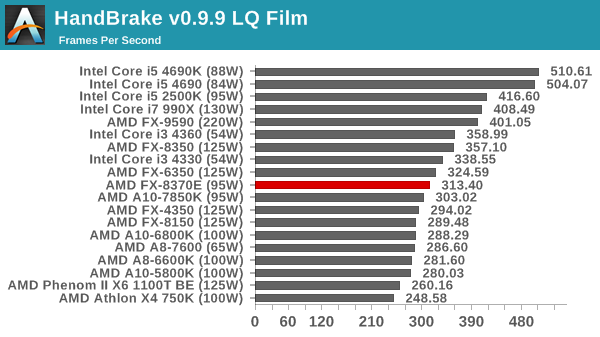
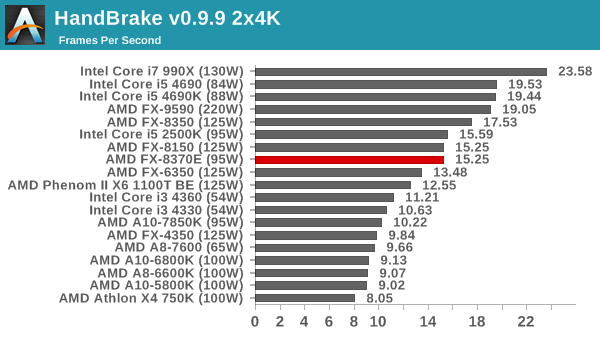
Handbrake balances cores and frequency, with the LQ film test often condensing CPUs based on frequency and the double UHD test expanding by cores. The double UHD test puts the 8370E at the bottom of the AMD 8-thread CPUs as expected.
Agisoft Photoscan – 2D to 3D Image Manipulation: link
Agisoft Photoscan creates 3D models from 2D images, a process which is very computationally expensive. The algorithm is split into four distinct phases, and different phases of the model reconstruction require either fast memory, fast IPC, more cores, or even OpenCL compute devices to hand. Agisoft supplied us with a special version of the software to script the process, where we take 50 images of a stately home and convert it into a medium quality model. This benchmark typically takes around 15-20 minutes on a high end PC on the CPU alone, with GPUs reducing the time.
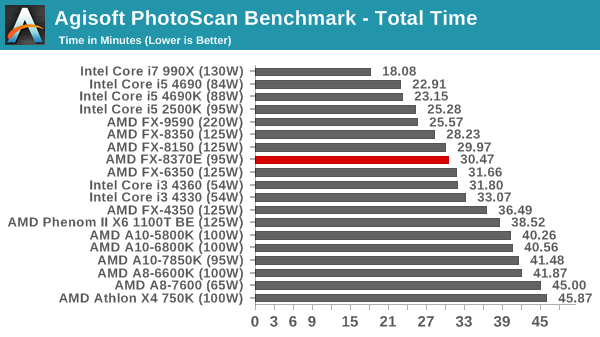
Photoscan results seem to take the following order: i7, i5, FX (8), FX (6), i3, FX (4), A10, A8. The 8370E sits at the bottom of the FX 8-thread section as before.
WinRAR 5.0.1: link
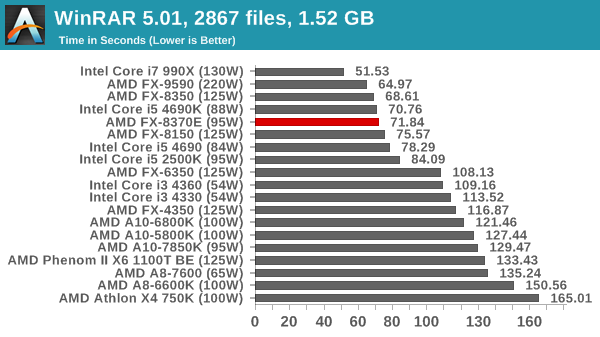
WinRAR takes advantage of all the AMD threads due to its integer workloads.
PCMark8 v2 OpenCL
A new addition to our CPU testing suite is PCMark8 v2, where we test the Work 2.0 and Creative 3.0 suites in OpenCL mode. As this test is new, we have not run it on many AMD systems yet and will do so as soon as we can.

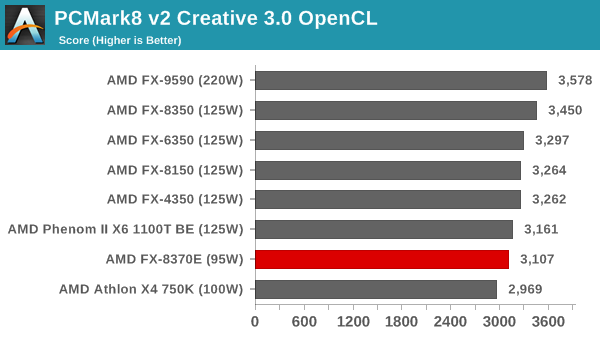
The PCMark8 tests both seem to favor frequency at this point, with the FX-9590 taking the lead.
Hybrid x265
Hybrid is a new benchmark, where we take a 4K 1500 frame video and convert it into an x265 format without audio. Results are given in frames per second.
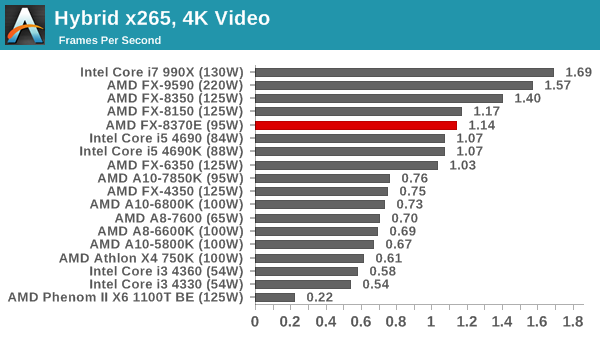
Again, more threads gives an intesting workload. The FX-8370E beats out the i5-4690K as well.
Cinebench R15
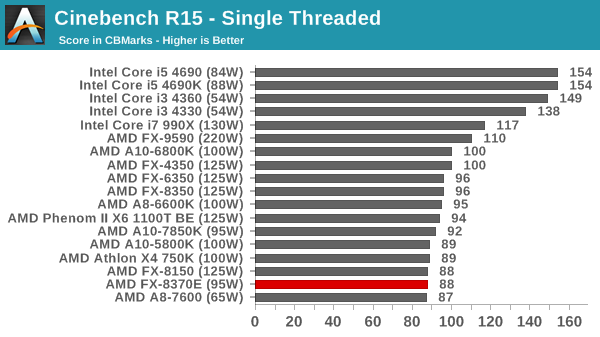
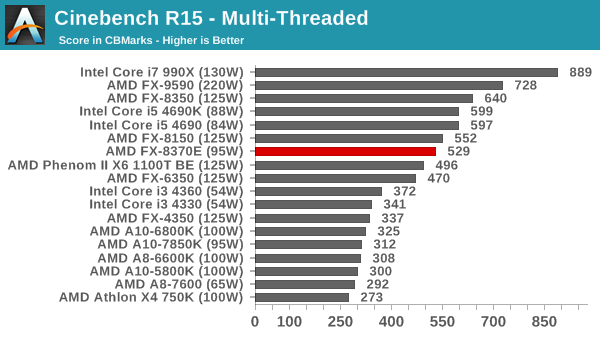
Unfortunately the Achilles heel strikes again in single threaded performance. Multithreaded puts it just behind the FX-8150.
3D Particle Movement
3DPM is a self-penned benchmark, taking basic 3D movement algorithms used in Brownian Motion simulations and testing them for speed. High floating point performance, MHz and IPC wins in the single thread version, whereas the multithread version has to handle the threads and loves more cores.

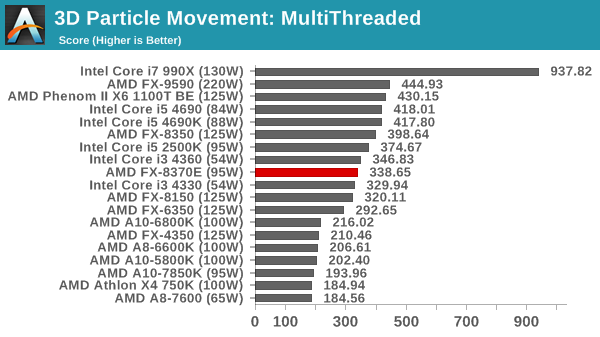
FastStone Image Viewer 4.9
FastStone is the program I use to perform quick or bulk actions on images, such as resizing, adjusting for color and cropping. In our test we take a series of 170 images in various sizes and formats and convert them all into 640x480 .gif files, maintaining the aspect ratio. FastStone does not use multithreading for this test, and results are given in seconds.
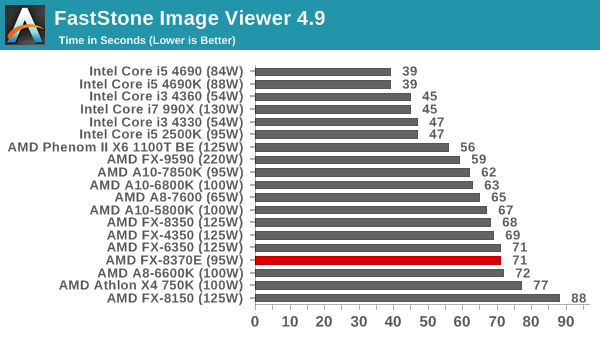
Web Benchmarks
On the lower end processors, general usability is a big factor of experience, especially as we move into the HTML5 era of web browsing. For our web benchmarks, we take four well known tests with Chrome 35 as a consistent browser.
Sunspider 1.0.2
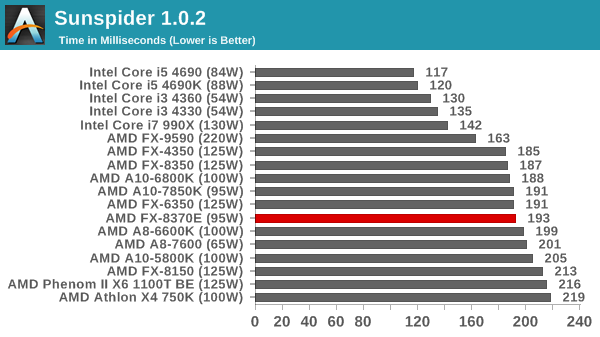
Mozilla Kraken 1.1

WebXPRT
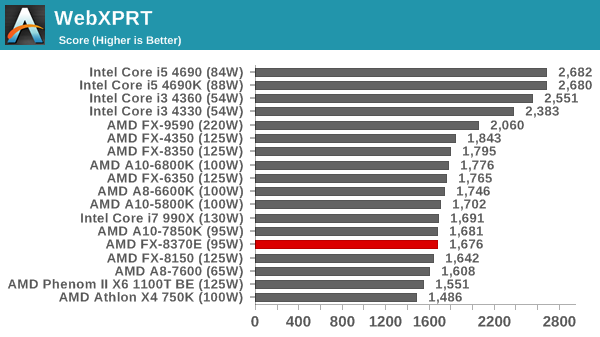
Google Octane v2
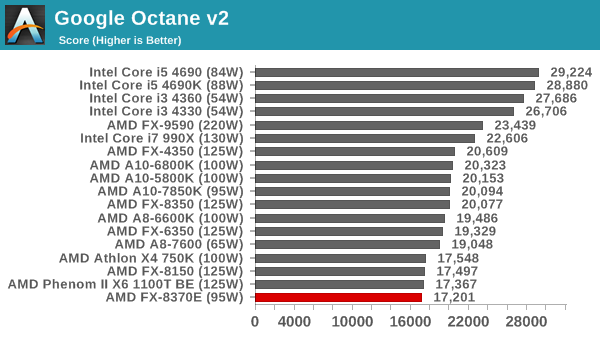










107 Comments
View All Comments
boot318 - Tuesday, September 2, 2014 - link
AMD, you sure the CPU speed is right? :/Good to see that power consumption is down (would like to get more data on it). I've been wanting to my my Phenom x3 that I have an office computer with an 8-core, and I might just do it with this one. Black Friday!!!!
ddriver - Tuesday, September 2, 2014 - link
Yeah, they fixed power consumption, all they need to do now is double the performance and they are back in the game LOLFlunk - Tuesday, September 2, 2014 - link
Hey, be nice to AMD. These new processors are totally competitive with Intel...'s Sandy Bridge processors from 3 years ago.Seriously AMD, Intel has almost been standing still for 3 years and you're still behind. Come up with something better or us enthusiasts are not going to have a reason to even look at your chips. Your GPUs are a good option, with competitive performance and better prices (I recommend Radeons in almost every price bracket right now because of this). If only AMD could put out some decent CPUs.
SpaceRanger - Tuesday, September 2, 2014 - link
Has anyone been looking at their chips seriously?? I stopped using AMD a long while ago. Intel blew them away and it'll take some competitive chips from AMD to get me to think otherwise.ddriver - Tuesday, September 2, 2014 - link
Don't get me wrong, I sympathize with underdogs, and especially considering in the case of AMD, it was decades of Intel's anti-competitive practices that have pretty much doomed AMD to be a perpetual runner up, but I can't deny the obvious. AMD is where Intel always wanted it to be - a handicapped "competitor", barely enough for Intel to say "we are not a monopoly". I've been a long time AMD consumer, but today it is not worth it, maybe on the low end where power consumption is not that much of an issue and the lower price may make some sense, at least in the short term. But ever since I became a prosumer, AMD CPUs simply have nothing to offer. Radeons are pretty neat though, since they offer tremendously better DP performance for the buck.Seriously, how hard is to make a decent CPU... Intel surely has a manufacturing lead as well, but the poor performance of AMD is mostly because of the inferior design, process might give Intel 20-30% advantage, but the rest is all the design.
On a side note, the CPU performance stalling is actually a good thing, even if AMD was competitive, there are physical limits which CPUs will hit soon, not to mention Intel has already reached the point the chips are too small to displace that much hear efficiently. I remember I used to upgrade CPUs every 18 months or so, but now I have a 2 year old CPU that is only a notch slower than the latest and greatest.
Moore's "law" is a dud, it is obvious that performance cannot exponentially grow, it is more of a half of bell shaped curve, as we reach physical limits, performance gains will slowly go stale. And quite frankly - that's OK, enough is enough. Did we really make much good use of extra performance? Nope, we got sloppy technologies, slow programming languages, bloated runtimes which kind of "equal out" the experience. I have 10 tabs in my browser open, with total content of all websites not exceeding 100 MB, and yet it takes 1200 MB of ram... Lousy skype, a puny messenger - 100 MB of ram usage? WTF?
Death666Angel - Tuesday, September 2, 2014 - link
"not to mention Intel has already reached the point the chips are too small to displace that much hear efficiently."So why is my i7-4770k @ 4.5GHz and 1.35V cooler (60°C core average while running Prime95 27.9, delidded) than my old i7-860 @ 3.8GHz and 1.34V (80°C core average with same load)? It is pretty much just Intel cheaping out on manufacturing of the consumer line CPUs, with weak TIM and too much glue for the IHS.
Death666Angel - Tuesday, September 2, 2014 - link
"Moore's "law" is a dud, it is obvious that performance"Way to show that you don't know jack. Moore's Law just says that the number of transistors on the same area will double every 2 years. Nothing about the performance of said transistors.
mrdude - Tuesday, September 2, 2014 - link
You forgot the economics portion of Moore's law, which ties number of transistors per dollar. If there wasn't a financial incentive, we would have never had the law in the first place ;) Shrinking didn't just improve die sizes (and almost always performance), but it also made economic sense. If you take into account the economic aspect, ddriver isn't far off. We're not far off heretofore hypothetical scenario of 'It's just too expensive and doesn't provide enough benefit anymore'. In fact, for some semicos we're already there.Samus - Wednesday, September 3, 2014 - link
Seriously, to imply that an IPC should double in performance every 24 months is ridiculously impossible.Moore's law is a law of production, not design.
ddriver - Wednesday, September 3, 2014 - link
Even so, that is impossible just as well. This would require that transistors can get infinitely small, which is simply not the case. There are limits to how small a transistor can be, and even in the case of insanely slow and expensive atomic assembly transistors will still be several atoms big, and that won't even make it in mass production.Moore's law IS A DUD and only applies to a short interval in time, Moore apparently didn't look far enough into the future, and made a foolish assumption transistors will keep shrinking perpetually, and even considering how thick chips were back in his days is no excuse for him making such a statement, nor is there any excuse to people who like religious zealots believe it will hold forever.
If you bother to actually map transistor size vs time you will not get a straight line but the half of an inverted bell shaped curve, indicating initially slow transistor shrinking, gradually speeding up towards the middle and gradually slowing down to a complete halt the decade or two.
Something like that: www.futuretimeline.net/subject/images/transistor-size-timeline.gif
however this one starts at the middle.